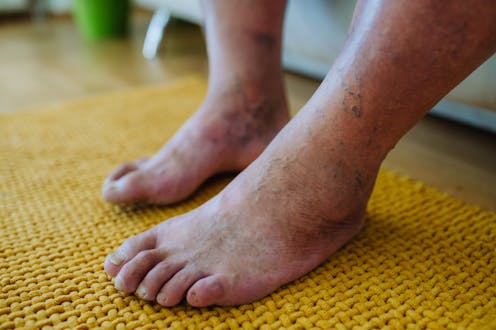
Gangrene, or a rapidly spreading foot abscess. Sound like diseases of the past? Well, sadly not.
Leg amputation is one of the oldest surgical procedures. The earliest known example dates back some 31,000 years. During the advent of modern surgery in the 19th century, amputation for trauma and infection was common. In the days before anaesthetic, surgeons had to be quick: Robert Liston, who was famed for his speed, could reportedly complete an amputation in 30 seconds.
While surgical practice has changed dramatically since then, one thing remains true: leg amputation is still far too common. Over 3,500 major leg amputations were performed by vascular surgeons in the UK in 2023.
Peripheral artery disease is the leading cause of amputations nowadays. Narrowings and blockages in the leg arteries lead to reduced blood supply in the legs and feet. This initially manifests as pain in the calf muscles when walking, but can progress to pain at rest, foot ulcers and even gangrene.
Preventing and promptly treating peripheral artery disease is essential. A 2024 Danish study reported stark findings: five years after diagnosis with peripheral artery disease, 10% of patients have had an amputation and 40% have died.
However legs (and lives) can still be saved – even at the end-stage of the disease – if treated quickly enough. Here are five ways you can reduce your risk of amputation.
1. Healthy lifestyle
Don’t smoke. And if you do smoke, stop now.
In the same way smoking clogs up coronary arteries and carotid arteries – causing heart attacks and strokes – smoking can fur up the arteries of the legs, causing peripheral artery disease.
Read more: Peripheral artery disease – the biggest killer you've probably never heard of
And even if you already have this disease, stopping smoking slows its progression and improves the effectiveness of treatment.
Diabetes is the other major modifiable risk factor for developing arterial disease. While neither diet nor obesity are strongly linked to peripheral artery disease, eating well and maintaining a healthy diet can prevent type II diabetes.
Diabetic foot disease – caused by a combination of complications from diabetes, including peripheral artery disease – is a leading cause of leg amputation. If you have diabetes, maintaining your blood sugars within target range is important to reduce the risk of developing complications, including diabetic foot disease and amputation.
2. Walk lots
Exercise really is one of the best medicines. Just 30 minutes a day of moderate-intensity exercise is recommended to help improve your cardiovascular health. Brisk walking, gardening, even ballroom dancing – anything that gets your heart and breathing rate up a bit.
Even for those with the early stages of peripheral artery disease, walking is one of the most effective treatments. And while a structured exercise programme is recommended, any walking – particularly to (or past) the onset of pain – will improve walking distance and quality of life.
Read more: Five ways to make your daily walks even more beneficial
3. Take the tablets
The benefit of taking medications for peripheral artery disease is unquestionable. The mainstay of this treatment is blood thinning with an antiplatelet medication (such as aspirin) plus cholesterol-lowering medication (statins). These medications combined significantly reduce the risk of heart attacks and strokes – the leading causes of death for those with peripheral artery disease. They also reduce the risk of amputation.
Research suggests that strict adherence to guidelines in UK patients would reduce their ten-year risk of heart attack, stroke or death by nearly 30%.
4. Good footwear and foot care
Badly fitting and inappropriate footwear is an all-too-common cause of foot ulcers in people at risk. This is especially true for people with diabetes, where numbness is common and rubbing from ill-fitting shoes can go unnoticed until it’s too late.
Properly fitted shoes that are wide enough to give room to all the toes are recommended. In people with a foot deformity caused by diabetes, shoes specially made or adapted by an orthotist – a healthcare professional who designs and creates footwear to reduce pain and increase mobility for patients – may be required.
All adults with diabetes should have an annual foot check for sensation, pulses and ulcers. It’s important to check feet frequently yourself, too – especially between the toes, heel and ball of each foot, which are common areas for ulcers. But they can be difficult to notice without looking for them.
People with diabetes often get dry feet, so be sure to moisturise twice a day with an over-the-counter aqueous cream. And if you have numbness in the feet, never, ever cut your own toenails! See a podiatrist regularly to do it for you.
5. Don’t ignore symptoms
And finally, seek urgent help if you or someone you know develop any signs of a foot at risk. Pain in the toes or heel at night or at rest; a foot wound that hasn’t healed for two weeks; any blueish or purple discolouration, or dry black patches to the toes.
Your GP should refer you urgently to a vascular surgeon if they are concerned you have the end-stage of peripheral artery disease – chronic limb-threatening ischaemia, where the leg is at risk without prompt restoration of blood supply.
In such cases, urgent treatment can save feet and legs.
John Houghton receives funding from the George Davies Charitable Trust and the National Institute for Health and Care Research. He is the trainee representative for the Vascular Surgery Specialist Advisory Committee and is a member of the UK Labour Party.
This article was originally published on The Conversation. Read the original article.







